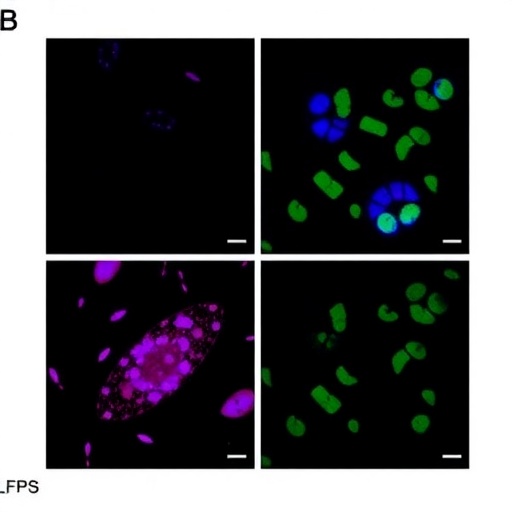
In a groundbreaking study, researchers led by Adhish and Manjubala have unveiled an innovative webserver named PPGBioPred, designed to predict the bioactivity of chemical compounds targeting the Peroxisome Proliferator-Activated Receptor Gamma (PPARγ). This finding holds significant implications in the realm of biochemical research, particularly in the context of the intricate Wnt/β-catenin signaling pathway, which plays a crucial role in various physiological processes and disease states. The Wnt/β-catenin pathway is notorious for its involvement in cancer, obesity, diabetes, and other metabolic disorders, making it a focal point for therapeutic development.
PPARγ is a member of the nuclear receptor family that regulates various genes involved in glucose and lipid metabolism. Understanding its regulatory mechanism is vital as it serves as a therapeutic target for a range of conditions, especially type 2 diabetes and other metabolic syndromes. The interaction of PPARγ with the Wnt/β-catenin signaling pathway surfaces as a key area of interest since it may influence the pathophysiological outcomes associated with various diseases. The PPGBioPred webserver simplifies the evaluation and prediction of potential compounds that can modulate this interaction, thereby aiding in the identification of novel therapeutic candidates.
The PPGBioPred webserver utilizes advanced computational algorithms to analyze the structural and chemical properties of various compounds, predicting their potential bioactivity against PPARγ. This advancement is substantial, as it rapidly accelerates the drug discovery process by providing researchers with the tools they need to assess the effectiveness of compounds without the need for lengthy experimental procedures. The predictive capabilities of PPGBioPred serve as a bridge between computational chemistry and pharmacology, potentially reducing the cost and time associated with traditional drug development.
In recent years, the application of machine learning and artificial intelligence has transformed the landscape of drug discovery. By integrating these technologies, PPGBioPred enhances the accuracy of bioactivity predictions. Researchers now possess the means to create databases of previously studied compounds, allowing for improved predictive analytics that can guide scientists in their search for new drugs. This tool not only predicts bioactivity but also provides insight into the underlying mechanisms at play within the Wnt/β-catenin signaling pathway.
The significance of PPGBioPred extends beyond mere prediction; it offers a platform for understanding the impact of PPARγ on cellular signaling processes. The interplay between PPARγ and Wnt/β-catenin is complex, influencing gene expression and cellular differentiation. Through the use of this webserver, scientists can explore how different compounds interact within this pathway, identifying potential leads for drug development that can disrupt disease processes at the molecular level.
Furthermore, the user-friendly interface of PPGBioPred enables researchers from various fields to utilize its capabilities effectively. By inputting chemical structures and relevant data, scientists can access the server’s predictions and insights with ease. This democratization of technology fosters collaboration across disciplines, enabling biochemists, pharmacologists, and molecular biologists to work together in their quest to innovate therapies that target metabolic diseases.
To supplement the functionality of the server, the research team offers resources such as detailed user guides and tutorials. This educational approach empowers users to understand the intricacies of the predictions made by PPGBioPred, thus enhancing their experimental designs. With the integration of user feedback, the webserver will continue to evolve, adapting to the changing landscape of biomedicine and compound discovery.
Looking ahead, the implications of PPGBioPred on drug development are profound. As researchers strive to combat the global increase in metabolic disorders, the predictive capabilities of this webserver can streamline the identification of effective compounds. This technology not only accelerates the discovery process but also has the potential to revolutionize clinical practices by bringing new, safe, and effective drugs to the market more efficiently.
In conclusion, Adhish and Manjubala’s development of the PPGBioPred webserver marks a significant advancement in the field of bioinformatics and drug discovery. By focusing on the bioactivity of compounds against PPARγ and their relationship with the Wnt/β-catenin signaling pathway, this tool paves the way for future research endeavors aimed at treating a multitude of diseases. The potential impact on public health is immense, offering hope for new therapeutic options as we navigate through the complexities of biochemical interactions and metabolic diseases.
With an increasing number of researchers seeking effective means to repurpose existing compounds and discover new ones, PPGBioPred is poised to become an invaluable resource in the scientific community. As the server gains traction, it is expected that collaborative efforts will emerge, ushering in a new era of innovation in drug discovery and development.
This exciting advancement in biocomputational tools presents a compelling case for the integration of technology and biology. As researchers harness the power of PPGBioPred, we can anticipate a wave of breakthroughs that could redefine our understanding of PPARγ, the Wnt/β-catenin pathway, and their contributions to health and disease.
Ultimately, the journey to find effective treatments is a collective endeavor that requires continuous development and adaptation of our scientific tools. With PPGBioPred, the path toward new possibilities in drug discovery appears brighter, as scientists around the world unite their efforts to combat the challenges posed by metabolic disorders.
Subject of Research: Bioactivity prediction of compounds against PPARγ in relation to the Wnt/β-catenin signaling pathway.
Article Title: PPGBioPred: a webserver for predicting the bioactivity of compounds against PPARγ involved in the negative regulation of the Wnt/β-catenin signaling pathway.
Article References:
Adhish, M., Manjubala, I. PPGBioPred: a webserver for predicting the bioactivity of compounds against PPARγ involved in the negative regulation of the Wnt/β-catenin signaling pathway.
Mol Divers (2025). https://doi.org/10.1007/s11030-025-11297-1
Image Credits: AI Generated
DOI: 10.1007/s11030-025-11297-1
Keywords: PPARγ, Wnt signaling pathway, drug discovery, bioinformatics, webserver, predictive analytics, metabolic disorders, bioactivity prediction.
Tags: biochemical research advancementschemical compound bioactivitycomputational algorithms in biochemistryglucose and lipid metabolism regulationmetabolic disorder therapeutic targetsnovel therapeutic candidates identificationnuclear receptor family researchobesity and cancer researchPPARγ bioactivity predictionPPGBioPred webservertype 2 diabetes treatment innovationsWnt/β-catenin signaling pathway




